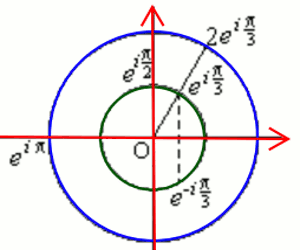Un nombre complexe peut être écrit sous différentes formes, au-delà de forme algébrique qui s’écrit : \(Z = a + ib\), nous pouvons aussi avoir :
I. Forme trigonométrique d'un nombre complexe
I.1 Définition
Soit \(Z = a + ib\), un nombre complexe de module \(r\) et d’argument \(\theta \). On appelle forme trigonométrique de \(Z\) toute écriture de la forme \(Z = r\) \(\left( {\cos \theta + i\sin \theta } \right)\) avec \(r = \) \(\sqrt {{a^2} + {b^2}} \) et
\(\theta \in \left[ { - \pi ;\pi } \right[\) \(\left\{ \begin{array}{l}\cos \theta = \frac{a}{r}\\\sin \theta = \frac{b}{r}\end{array} \right.\)
I.2 Propriétés
Soient \(Z\) et \(Z’\) deux complexe tels que \(Z = r\) \(\left( {\cos \theta + i\sin \theta } \right)\) et \(Z' = r'\) \(\left( {\cos \theta ' + i\sin \theta '} \right)\)
P.1 \(Z \times Z' = r \times r'\) \((\cos \left( {\theta + \theta '} \right)\) \( + i\sin \left( {\theta + \theta '} \right))\)
P.2 \(\frac{Z}{{Z'}} = \frac{r}{{r'}}\) \((\cos \left( {\theta - \theta '} \right) + \) \(i\sin \left( {\theta - \theta '} \right))\)
P.3 \({Z^n} = {r^n}\) \(\left( {\cos n\theta + i\sin n\theta } \right)\)
N.B : si \(r = 1\) \({Z^n} = \) \(\left( {\cos n\theta + i\sin n\theta } \right)\)
II. Forme polaire d’un nombre complexe
II.1 Définition :
Soit \(Z\) un nombre complexe de module \(r\) et d’argument \(\theta \), On appelle forme polaire de \(Z\) toute écriture de Z de la forme \(Z = \left[ {r;\theta } \right]\)
II.2 Propriétés :
Soient \(Z\) et \(Z'\) deux complexe tels que \(Z = \left[ {r;\theta } \right]\) et \(Z' = \left[ {r';\theta '} \right]\)
P.1 \(Z \times Z' = \) \(\left[ {r \times r';\theta + \theta } \right]\)
P.2 \(\frac{Z}{{Z'}} = \) \(\left[ {\frac{r}{{r'}};\theta - \theta '} \right]\)
P.3 \({Z^n} = \) \(\left[ {{r^n};n\theta '} \right]\)
III. Forme exponentielle d'un nombre complexe
III.1 Définition
Soit \(Z\) un nombre complexe de module \(r\) et d’argument \(\theta \). On appelle forme exponentielle d'un nombre complexe \(Z\), toute écriture de \(Z\) se ramenant sous la forme \(Z = r{e^{i\theta }}\) où son conjugué est \(\overline Z = r{e^{ - i\theta }}\)
III.2 Propriétés :
Soient \(Z\) et \(Z’\) deux nombres complexes de formes exponentielles respectives : \(Z = r{e^{i\theta }}\) et \(Z' = r'{e^{i\theta '}}\)
P.1 \(Z \times Z' = \) \(r \times r'{e^{i\left( {\theta + \theta '} \right)}}\)
P.2 \(\frac{Z}{{Z'}} = \frac{r}{{r'}}\) \({e^{i\left( {\theta - \theta '} \right)}}\)
P.3 \(Z \times \overline Z = \) \(r \times r'\) \({e^{i\left( {\theta - \theta } \right)}} = {r^2}\)
P.4 \({Z^n} = {r^n}{e^{in\theta }}\)
P.5 : Formule d'Euler
\(\left\{ \begin{array}{l}\cos \theta = \frac{{{e^{i\theta }} + {e^{ - i\theta }}}}{2}\\\sin \theta = \frac{{{e^{i\theta }} - {e^{ - i\theta }}}}{2}\end{array} \right.\) soit \(\left\{ \begin{array}{l}\cos n\theta = \frac{{{e^{in\theta }} + {e^{ - in\theta }}}}{2}\\\sin n\theta = \frac{{{e^{in\theta }} - {e^{ - in\theta }}}}{2}\end{array} \right.\)

